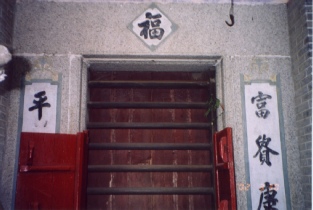

MYTD
Our last name consists of two Chinese characters. It is one of the few Chinese last names that have more than one Chinese character. The Chinese characters of our last name are as follow:
 The meaning of this character by itself is; a person responsible for a function or
department; or manager; or department head. It is pronounced as; 1) In our village
dialect -
The meaning of this character by itself is; a person responsible for a function or
department; or manager; or department head. It is pronounced as; 1) In our village
dialect -
This character does not seem to have a meaning by itself. It requires another character
to express a meaning. It is pronounced as; 1) In our village dialect -
In ancient China, these two characters together was the title of the Primer in charge of etiquette. In modern Chinese these two characters together does not seem to have a meaning other than our last name.
English translation of our last name
There are quite a few translations of this last name over the years.
1) Before 1950, most people who went overseas were from villages in Kaiping so they
spoke the village dialect. They translated their last name as; Shoo-
2) After 1950, many people went overseas from Hong Kong so they adapted a Cantonese translation which are; Seto, Szeto, and Szto to name just a few. I have been wondering why not Seato.
3) I do not know under what circumstances a mandarin translation would be used. I suppose they have to be from the group who moved to Shanghai before world war II or after 1950 from Taiwan. Now, Hong Kong has a large Mandarin speaking population. These groups might have translated their last name as; Situ, or Sitwu or Sytwu, or Sytu or a variety of that. So far I had not met one with any of these names.
There is a certain controversy over where our last name came from and why.
One school of thought is that our last name was derived from the name of a high ranking officer in the court of the Emperor, Primer of Etiquette. Since that position had been mentioned in very early Chinese history therefore our last name is very old. I remember when I visited Japan for business and when I was introduced many Japanese knew that Seto was a high ranking official in the Chinese Court and they told me so. They also interpreted that was the source of my last name.
Another school of thought is that our last name was converted from another Chinese last name only a few hundred years ago. This conversion was the result of running away from central China. Our ancestor was told by a fortune teller to change the last name to Seto. What was the original last name? That is also a controversy. Some say Shih and others others.
Here are some facts:
1) Before the communist took over China, almost all Setos’ were inhabiting this island
in Kaiping. There was no known Setos’ in other parts of China except one family
in Shanghai. They moved there from Kaiping. There were quite a few Setos’ in North
America, and South East Asia. All Setos’ spoke the same dialect which is close to
Cantonese and very different from Mandarin (Po-
2) The position of situ which was the title of the Primer of Etiquette was indeed
in existence long time ago. I think, the most famous person who had that position
was situ Wang Ywuen in the pseudo-
If we want to know more then we need to do more research to find out. There is a library in this little town Chek Hum, in Kaiping. The name of this library is called Seto Ci library. May be we can find some leads there. May be the Seto Clan Association in San Francisco has information as well.
Any comments, thoughts and suggestions are welcome.
